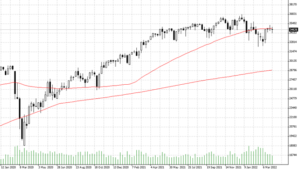

08.04.2022 – NATO will now supply Ukraine with heavy weapons. And the U.S. is launching the Lend-Lease Act, which will give Kiev virtually unlimited access to American weapons. Tough times for traders and investors – the war is just getting started. We shed light on the background and look at four possible scenarios.
The Bucha massacre has changed everything. The West now sees heavy weapons as defensive. Apparently, the first tanks are already heading for Ukraine. Investors have not really registered this yet. In the weekly chart, the Dow Jones is trying to regain the 50 line. From below, the 200 line and the low from the Corona crash are tempting.

Source: Bernstein Bank GmbH
The tussle of arms in Ukraine may soon resemble World War II with open field battles. Another parallel: apparently Russian Speznas commandos in dark green and black uniforms, different from the spotted camouflage of the conventional army, have carried out ethnic cleansing. Interrogations, rapes, shootings. This is indicated by intercepted telephone calls, satellite images, witness statements, found ammunition boxes and insignia. This is reminiscent of the Einsatzgruppen of SS and SD behind the Eastern Front. The Russian Spezialnovo Nasnachenija, units for special use, exist for example in the secret service FSB and the military secret service GRU.
Threat of a major Russian offensive
That’s why NATO is taking off the kid gloves. It is necessary to use the window before Moscow launches its next major attack and is in a “decisive phase,” NATO Secretary General Jens Stoltenberg said Tuesday. It will take “several weeks” for Russian troops to regroup and be armed, he said. In that window of time, he said, it is extremely important that NATO allies provide support. Indeed, cell phone videos of platoons of Russian tanks rolling toward Ukraine have been circulating on the Internet.
Tanks and air defense
According to the “Frankfurter Allgemeine Zeitung,” there are also signs in the West that a veritable armed force is being built up: 35 states participated in an arms builders’ conference last week. According to the British, the participants committed themselves to providing Ukraine with air and coastal defense systems, artillery and anti-artillery capabilities, armored and protected vehicles. Even Berlin is probably allowing a Czech company to resell 56 tanks from GDR stocks to Ukraine. It is possible that Germany could also supply used Marder infantry fighting vehicles.
Unlimited weapons through Lend-Lease
Hardly noticed by the local quality media, something historic has also happened in the USA: The Senate has passed the “Ukraine Democracy Defense Lend-Lease Act of 2022”. The House of Representatives still has to approve it, but this is probably a formality. This means that the White House no longer needs to have its own budget approved by Congress for arms deliveries – the president can decide everything on his own via directive without bureaucracy. Ukraine can use the weapons now and pay for them later (maybe). Such a law already brought the decisive turnaround in World War II, when the USA massively rearmed Great Britain and the USSR against Nazi Germany before entering the war itself.
Four options
Thus, the financial market faces four possible developments. First, either the Kremlin relents soon and pulls back. That would be a bullish case for stocks and a return to normalcy. Second: Or we see a war that dwarfs everything that has gone before – with a possible escalation because Vladimir Putin sees the West’s armament as a declaration of war or uses nuclear weapons in the face of certain defeat. Then we don’t need to talk about investments anymore. Third, Ukraine wins a conventional war, Putin is deposed or no longer dares new adventures. That would also be bullish. Fourth: Or Russia is victorious, secedes the Donbass or suppresses Ukraine in an occupation lasting for years. In that case, we can expect a collapse in prices at first, but then a slow return to day-to-day trading.
Our advice: prepare for a potential violent quake on the stock market, use the time. Deutsche Bank just warned in an analysis that the war has already caused turmoil in several energy, food and commodity markets, further disrupting the supply chain. We think: There may be more to come. Bernstein Bank hopes for peace soon and keeps an eye on the situation for you.
Important Notes on This Publication:
The content of this publication is for general information purposes only. In this context, it is neither an individual investment recommendation or advice nor an offer to purchase or sell securities or other financial products. The content in question and all the information contained therein do not in any way replace individual investor- or investment-oriented advice. No reliable forecast or indication for the future is possible with respect to any presentation or information on the present or past performance of the relevant underlying assets. All information and data presented in this publication are based on reliable sources. However, Bernstein Bank does not guarantee that the information and data contained in this publication is up-to-date, correct and complete. Securities traded on the financial markets are subject to price fluctuations. A contract for difference (CFD) is also a financial instrument with leverage effect. Against this backdrop, CFD trading involves a high risk up to the point of total loss and may not be suitable for all investors. Therefore, make sure that you have fully understood all the correlating risks. If necessary, ask for independent advice. CFDs are complex instruments and are associated with the high risk of losing money quickly because of the leverage effect. 68% of retail investor accounts lose money trading CFD with this provider. You should consider whether you understand how CFD work and whether you can afford to take the high risk of losing your money.7
